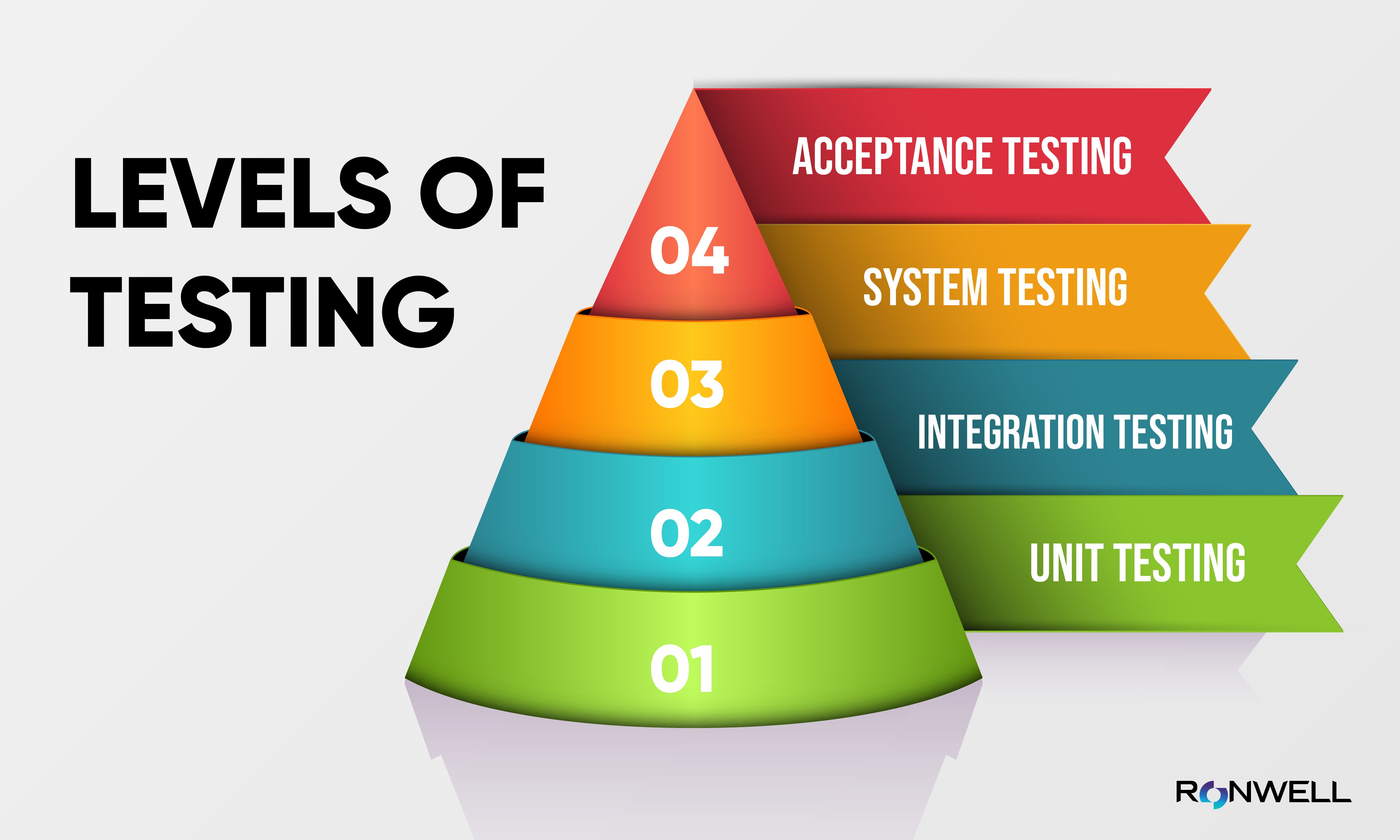

Our Services
Test Automation ServicesAI & Machine LearningBlockchainCRM ConsultingData Science & EngineeringDevOpsDigital MarketingDigital TransformationEmbedded Software DevelopmentERP Consulting ServicesManaged IT ServicesMergers & Acquisitions AdvisoryQA And Testing ServicesRobotic Process Automation SAP Consulting DevelopmentSoftware and Application DevelopmentSQL ConsultingStrategy ConsultingSustainability
- Contact Us
Our Services
- Test Automation Services
- AI & Machine Learning
- Blockchain
- CRM Consulting
- Data Science & Engineering
- DevOps
- Digital Marketing
- Digital Transformation
- Embedded Software Development
- ERP Consulting Services
- Managed IT Services
- Mergers & Acquisitions Advisory
- QA And Testing Services
- Robotic Process Automation
- SAP Consulting Development
- Software and Application Development
- SQL Consulting
- Strategy Consulting
- Sustainability
Insight
Company
Industries
- Contact Us

Understanding Levels of Testing: For a Better Software
Boost your software quality with our guide to the four levels of testing: unit, integration, system, and acceptance testing. Read on to learn more.
- insight
- /
- blog
- /
- levels-of-testing
Software testing is an important aspect of software development that ensures that software products meet the desired quality standards.
It involves validating and verifying software to ensure that it meets the requirements and specifications, design, and coding. There are different levels of software testing that developers use to test software products, each with its own objectives and focus.
Four main levels of software testing are widely recognized in the industry: Unit Testing, Integration Testing, System Testing, and Acceptance Testing. Each level of testing is important to ensure that the software is functional, reliable, and meets the requirements specified by the stakeholders.
Discover the Ultimate Guide to Over 100 Types of Software Testing.
In this blog, we will explore the different levels of software testing, their goals, and the types of tests commonly performed at each level. Understanding these levels of software testing will help you develop high-quality software that meets the expectations of your end users.

Unit Testing
Unit testing, also called component testing, is the most basic type.
Unit testing is a software testing technique that involves testing individual units or components of a software application in isolation from the rest of the system. Its primary aim is to verify that each unit functions as intended and adheres to the design specifications.
During the testing, the developer typically writes automated test cases that exercise the functionality of the individual unit. The test cases are designed to cover different scenarios and edge cases to ensure that the unit works correctly under different conditions. The test cases can be run repeatedly as the code is updated, providing quick feedback to the developer if any changes break the functionality of the unit.
For more, read our blog: Unit Testing vs. Functional Testing: A Detailed Comparison.
Unit Testing is typically performed early in the development process, as soon as a unit or component is completed. By catching defects early in the development cycle, Unit Testing can help reduce the cost of fixing defects and improve the overall quality of the software. Here are the advantages and disadvantages of unit testing.
Unit Testing Advantages:
- Detects regression bugs
- Helps to catch bugs/defects earlier, which saves both time and money
- Helps to understand the behavior of the code
- The cost of conducting unit testing is low.
Disadvantages of Unit Testing:
- Writing test cases takes time.
- Unit testing is incapable of detecting all errors.
- GUI code testing must be performed correctly, as it will be challenging to test the software’s graphical user interface using unit testing.
Learn More: What is Comparison Testing? Advantages, Disadvantages & Examples
Integration Testing
Integration Testing coming after unit testing, is the second level of software testing.
Integration testing is a software testing technique that involves testing the integration of different software components to ensure that they work together as expected. Integration testing aims to detect any defects in the interaction between the integrated components.
Integration testing is typically done after unit testing and right before system testing. It can be performed in different ways, including top-down, bottom-up, and incremental testing.
Top-down integration testing starts with the highest-level module and gradually adds lower-level modules until the entire system is integrated and tested. Bottom-up integration testing starts with the lowest-level module and gradually adds higher-level modules until the entire system is integrated and tested. Incremental testing integrates and tests the system in small increments, adding and testing new functionality as it is developed.
During integration testing, testers may use various techniques, such as stubs, drivers, and test harnesses, to simulate the behavior of the components that have not yet been developed or tested. This allows testing to continue even if some components are not yet available.
Learn about the principle of software testing.
The main goal of integration testing is to ensure that the integrated system works as expected and that all components communicate and interact correctly. By detecting and resolving integration issues early in the development cycle, integration testing helps reduce the overall cost and time of software development.
Integration Testing Advantages:
- Increases test coverage
- Provides a higher level of reliability
- Helps identify integration issues between modules
- Ensures integrated components work properly before proceeding to system testing
- Bugs discovered at this level are easier to resolve than those found later in testing
Integration Testing Disadvantages:
- Can be complex and time-consuming, especially when testing large and complex systems.
- Testing the integration between modules can be time-consuming and resource-intensive
- Requires the creation of stubs and drivers, which, if not done correctly, can result in insufficient testing
- Lower-level modules need to be adequately tested
- Test output can be difficult to observe.
System Testing
System testing evaluates the behavior of a complete and integrated system to verify that it meets specified requirements. The purpose of system testing is to validate that the entire system functions correctly and performs as expected in a real-world environment.
System testing is normally done after integration testing. It is designed to test the entire system, including its interfaces with other systems, to ensure that all components work together correctly.
This testing technique can be used to identify any defects that may have been missed during the previous testing phases and to ensure that the system meets all the specified functional and non-functional requirements.
During system testing, various test cases are executed to verify the system's functionality, performance, security, and usability. This may involve running automated tests, conducting manual tests, or a combination of both.
To learn more, read Manual testing vs. automated testing.
The results of system testing help to determine whether the system is ready for release to end-users or requires further refinement before it is considered complete.
System Testing Advantages:
- Helps to identify defects that may have been missed during earlier testing phases, such as integration or unit testing.
- Verifies that the entire system works correctly and meets all functional and non-functional requirements.
- Provides a comprehensive evaluation of the system's performance, reliability, and security.
System Testing Disadvantages:
- Can be time-consuming and expensive, especially when testing large and complex systems.
- System testing may require additional hardware or software to simulate the production environment.
- System testing may not be able to catch all defects or issues, especially those related to user experience or usability.
Acceptance Testing
Acceptance testing checks whether a software application meets the requirements and specifications and is suitable for delivery to the end-users or customers. It is usually the final phase of testing before the software is released.
Acceptance testing aims to verify that the software meets the end user's needs and is ready for deployment. The end-users or customers usually carry out this testing to ensure that the application meets their expectations and works as intended in their environment.
Acceptance testing can be done through a variety of techniques, including manual testing, automated testing, or a combination of both. If you're wondering what is automation testing, read our blog.
This testing can be performed using various methodologies, such as black-box testing, white-box testing, or gray-box testing. For more information about white box testing and black box, check the blog Difference Between Black Box Testing and White Box Testing.
Typically, acceptance testing involves testing the functionality, usability, reliability, performance, and security of the software. The results of acceptance testing are used to make decisions about whether the software is ready for release or needs further improvements.
Advantages of Acceptance Testing:
- Early identification of potential issues in new products before they are released to end-users.
- Clients can test and evaluate the software's features to ensure they meet their requirements.
- Increases client satisfaction and reliability by giving them an opportunity to validate the software themselves.
- Helps the client to understand their target audience better by analyzing the data gathered during acceptance testing.
Disadvantages of Acceptance Testing:
- Requires significant resources and test planning to implement effectively.
- Clients may have limited input into which test cases are used during acceptance testing.
- It can be challenging to assess the progress of acceptance testing accurately.,
Bottom Line
In conclusion, software testing is a critical process that helps ensure that the software functions as expected and meets the user's requirements. The different levels of software testing, including unit testing, integration testing, system testing, acceptance testing, and regression testing, each have its own unique purpose and scope.
By understanding the different levels of software testing and their importance in the software development life cycle, software developers and testers can create effective testing strategies that help ensure the software's quality and reliability. To learn more, check Test Automation Strategy: Importance, Benefits & Example.
By investing in software testing, organizations can avoid costly software failures and improve their overall customer satisfaction, making it an essential component of any successful software development project.
Need a professional testing service? Ronwell is here to help you with your testing needs!
References
Browser Stack - Types of Testing
Shiksha - Different Levels of Testing in Software Development
Writer:

Halime Yılmaz
Content Marketing Specialist
7 min read
30 March 2023, Thursday
Related Posts
Related Industries
Related Services















